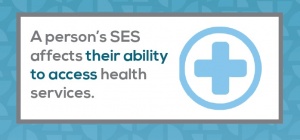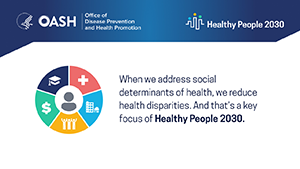
Vulnerable Populations
In order to help eliminate health disparities, those with low socioeconomic status must be afforded the same level of access to care as others.
Health is influenced by many factors, including level of education and family income and the resources and opportunities they provide, like access to affordable nutritious food and adequate housing. Health outcomes are also transformed by factors such as economic stability, health literacy and health insurance as well as access to quality-oriented preventive and comprehensive healthcare services, information and resources, among other factors.
Socioeconomic status continues to have a major role in influencing the prevalence of behavioral risk factors for cancer as well as access to routine cancer screening recommendations.
Education:
Populations with greater levels of educational attainment are less likely to die prematurely (younger than 65) from colorectal cancer compared to populations with less education, regardless of race or ethnicity. Reference: National Cancer Institute (NCI)
Disparities in colorectal survival are largely driven by socioeconomic inequalities that result in differences in
access to early detection tests and the receipt of timely, high-quality treatment along the cancer care continuum.
Reference: American Cancer Society. Colorectal Cancer Facts & Figures 2017-2019. Atlanta: American Cancer Society; 2017
Women with low socioeconomic status (SES) characteristics or who are socioeconomically disadvantaged, who report food insecurity, or report post-traumatic stress disorder (PTSD) or history of trauma have increased risk of smoking during pregnancy.
Reference: Scherman, A., Tolosa, J. E., & McEvoy, C. (2018). Smoking cessation in pregnancy: a continuing challenge in the United States. Therapeutic Advances in Drug Safety, 9(8), 457–474.
Geography:
Populations in medically underserved areas are more likely to be diagnosed with advanced stage or late-stage diseases (including cancers) that might have been treated more effectively or cured, if diagnosed earlier.
Reference: National Cancer Institute (NCI) available at: https://www.cancer.gov/about-nci/organization/crchd/about-health-disparities/examples
Even though populations in rural communities often experience worse health outcomes (including some types of cancers) and less access to healthcare compared to metropolitan/urban communities, racial/ethnic minority populations residing in rural communities experience substantially unfavorable health outcomes and access to care challenges that are sometimes overlooked when considering only aggregated population data.
Reference: James CV, Moonesinghe R, Wilson-Frederick SM, Hall JE, Penman-Aguilar A, Bouye K. Racial/Ethnic Health Disparities Among Rural Adults — United States, 2012–2015. MMWR Surveill Summ 2017;66(No. SS-23):1–9.
Access to Care:
Cancer disparities among uninsured adult patients exist by census tract–level poverty, rurality and race/ethnicity.
Reference: Han X, Yabroff KR, Ward E, Brawley OW, Jemal A. Comparison of Insurance Status and Diagnosis Stage Among Patients With Newly Diagnosed Cancer Before vs After Implementation of the Patient Protection and Affordable Care Act. JAMA Oncol. 2018;4(12):1713–1720.
Populations with financial toxicity are more likely to report noncompliance with medication, owing to inability to afford prescription drugs, and reported forgoing physician visits and medical tests.
Reference: Financial Toxicity in Adults With Cancer: Adverse Outcomes and Noncompliance. Thomas G. Knight, Allison M. Deal, Stacie B. Dusetzina, Hyman B. Muss, Seul Ki Choi, Jeannette T. Bensen, and Grant R. Williams. Journal of Oncology Practice 2018 14:11, e665-e673.
Populations with low socioeconomic status characteristics such as: low-income, uninsured populations, and racial/ethnic are less likely to receive cancer prevention and screening (evidence-based), and they are more likely to be diagnosed with late or advanced disease.
Reference: Yabroff KR, Gansler T, Wender RC, Cullen KJ, Brawley OW. Minimizing the Burden of Cancer in the United States: Goals for a High-Performing Health Care System. CA Cancer J Clin. 2019; 69:166‐183.

References:
- Centers for Disease Control and Prevention. Factors That Contribute to Health Disparities in Cancer. 2014 July 21. Retrieved from http://www.cdc.gov/cancer/healthdisparities/basic_info/challenges.htm
- American Cancer Society. Cancer Facts & Figures 2015. 2015. Retrieved from http://www.cancer.org/research/cancerfactsstatistics/cancerfactsfigures2015
- Centers for Disease Control and Prevention. Reducing Health Disparities in Cancer. 2014, July 21. Retrieved from http://www.cdc.gov/cancer/healthdisparities/basic_info/disparities.htm
- Agency for Healthcare Research and Quality. 2014 National Healthcare Quality & Disparities Report. 2014. Retrieved from http://www.ahrq.gov/research/findings/nhqrdr/nhqdr14/key1.html.
- Centers for Disease Control and Prevention. CDC Health Disparities and Inequalities Report- United States 2013. 2013 November 22. Retrieved from http://www.cdc.gov/mmwr/pdf/other/su6203.pdf

 Social Determinants of Health in Cancer Care (American Society of Clinical Oncology)
Social Determinants of Health in Cancer Care (American Society of Clinical Oncology)
